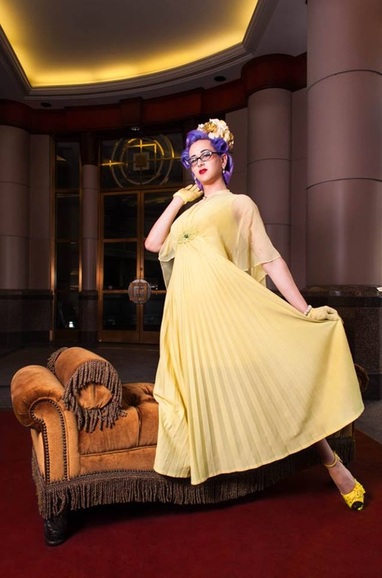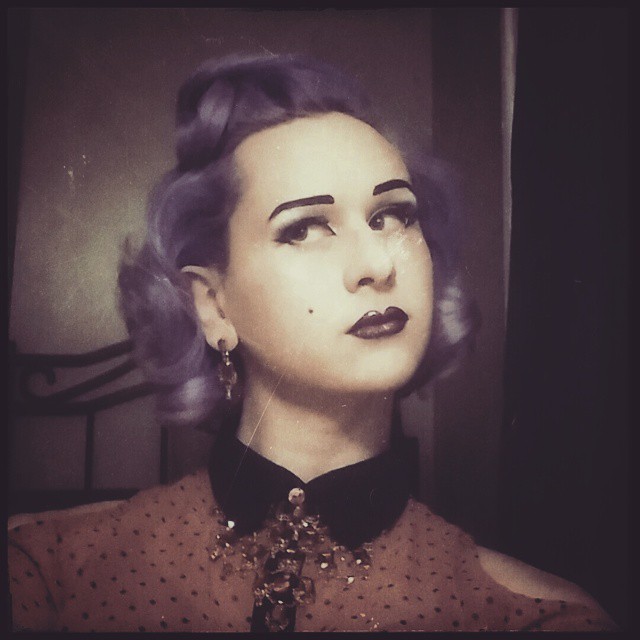
We are honored to speak with Eileen Galvin from Columbus first.
 Image by Eric Paul Owens
Image by Eric Paul Owens In 2011, I was still in school at OSU and I had just performed drag for the first time at the Q-Pid Valentine’s Day dance. Soon thereafter I met a member of local queer burlesque troupe Viva! and the Velvet Hearts, who were hosting a monthly LGBT mixer called Fusion Friday. At the time I had no real sense of what burlesque was, but I always enjoyed dance and dress up as a child and relished the thought of being validated onstage for the more feminine aspects of myself - aspects that were inaccessible to me as a person assigned male at birth, having been socialized as a boy in a strictly binary gender culture. As I began to explore my persona and develop acts, the stage felt like an alternate dimension where all the normal rules of gender identity and expression didn’t apply. Now, I co-own Crimson Lace Cabaret, a dance company showcasing burlesque, dance, drag and gender performance. As we I dance, I try to further chart that uncharted and possibly unchartable space.
When you perform burlesque, how do you transcend gender through performance ?
Part of the reason I love burlesque is because it is a transgressive art form. It’s performed live, in front of an audience, where the performer divests themselves and presents their body for public consumption. Usually the act calls forth and challenges sexual and gender mores, such as the sexual power of women or the acceptability of different body types, but burlesque is also capable of discussing other cultural systems as well, such as race, ability and virtually any other intersectionality of identity. In my case, as a male-assigned person who enjoys femme expression but identifies with neither iconic gender, as I reveal my body I am inviting the audience to have a discussion about gender politics. I do not typically wear fake hair, breasts, or pads to change the shape of my body. By avoiding illusionism I try to get the audience to analyze their assumptions about gender. The other reason I enjoy burlesque is because I find the experience of shedding clothing cathartic. For me it represents a transcendent but futile attempt at shedding a gendered state of mind and state of being.
How has burlesque helped you in your journey?
Burlesque springboarded me into my transition. When I first began performing I used it simply as a way to safely access and express femininity, which I did not yet feel safe doing in public space. At that time I was not even comfortable wearing a bra or a skirt in public. Over time, and with the help of loving friends and colleagues, I came to understand that gender is a cultural institution comprised of myriad performative practices. Eventually, experience within the performance context empowered me to translate those expressions into other contexts in my life. Performing burlesque helped me develop the courage to be my authentic self; now, Eileen is the name I use almost everywhere in my life. You might say I became my stage persona, and then it became me.
How do you feel about burlesque being friendly to transgender performers?
Is it inclusive?
I am thankful to say that so far in my career I have not been made to feel either tokenized or excluded for being trans. Performers and venues have been very receptive to my work and at least to my knowledge my identity or expression has not been an issue. I love this community.
Any issues you have had in your journey with burlesque?
Apart from personal struggles, there have been times where I received negative energy from audience members. Of these experiences, most were men, and the ones I actually spoke to were straight-identified. Usually what happens in such a situation is an audience member’s expectations about what my body looks like under my clothes are disrupted, and then they have difficulty reconciling that. Some people have walked out during my act, others given distasteful looks, or whispered audibly, “That’s a dude!” as I passed on my way offstage. Still others have approached me after an act and tried to place me back within the confines of heteronormativity by bestowing accolades of how convincing or passable I look. I find such “compliments” transphobic and reductive, and completely beside the point of what my dance is trying to achieve. These experiences are painful, but my stage persona has galvanized me against taking such encounters too personally. I know deep inside that I am a sparkle pony and that’s enough.
First of all for anyone, transgender or cisgender, burlesque is a journey inward to find your sexual power. It may be scary, or nerve-wracking, or full of emotional turmoil at first, but if you find taking your clothes off onstage makes you happy and empowered, keep going. Burlesque has become my therapy, and now I can’t imagine my life without it.
Secondly, find a support network. If you are near other performers, learn from them. Study the professionals in the field, learn the tricks of the trade, where to get the sparkliest rhinestones for the best deal. In any arena of life, friends to support and who will support you make it worthwhile.Finally, be daring and try new things! Take classes, travel and see what other cities are doing, add to your repertoire, maybe do a number that pushes you outside your comfort zone. Part of burlesque is taking your fears and punching them in the face!
Tell us about your first festival experience.
The first festival I attended was the Windy City Burlesque Festival in 2012. I performed in a group chair number and I was nervous to do well, and anxious about meeting national performers. I was so grateful to be traveling and performing in a group, it made the work much more manageable because we could help one another rehearse, pack, travel, etc. It was a very important experience for me because the act we brought was well-received act and it showed me that I was beginning to hone my craft.
What do you think is one of the most difficult challenges in
the trans* community for you?
In some instances in the past I’ve found that segments of the trans community disagree on the membership of non-binary and non-operative transfolk. The term “transgender” as I see it is an umbrella term for many different experiences, but at its core is a disparity between the sex that one was assigned at birth and the gender roles to which one was acculturated since birth. For some this term can also describe a subset of individuals who undergo or plan to undergo hormone replacement therapy, sex reassignment surgery, or both. I tend to believe because of my Queer, postmodern gender politics that essential qualities that define identity labels don’t exist. Rather, the individuals who don these labels define the collective identity through their words and actions. Identity politics are always complicated!

I work in IT at an art school, which is great because I am surrounded by creative energy every day. My schedule is very regular, which allows me to put much of my evenings and weekends into running CLC and performing. I am a mix of introvert and extrovert, so I enjoy working, performing and going out, as well as spending quiet evenings crafting costumes, rehearsing and being with my wonderful boyfriend of 4 years. Finding these balances has been key to getting the most possible out of life.
How do you wish your bravery be example to others?
I don’t think of myself as brave because I do not think of being trans or doing burlesque as anything out of the ordinary. Doctors heal the sick, astronauts go into space and I tease my hair up real big and shake it. I will say that when I look back on my work, I hope that the audience who saw it will rethink what and who and how gender is, and if even one person saw my act and thought, “Huh. If she can shake it, maybe I can too,” it will all have been worth it.
You can catch her in Columbus with Crimson Lace Cabaret.
Thank You, Readers.



 RSS Feed
RSS Feed
